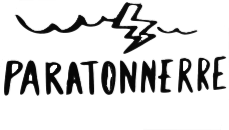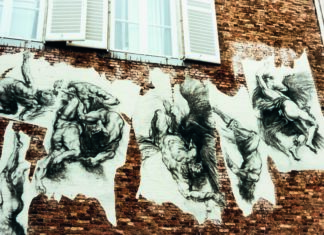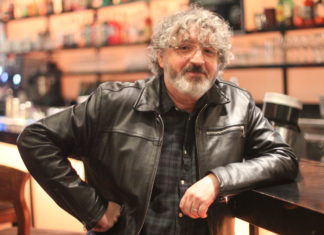Les Américains ont toujours eu une vision romantique de leur passé avec ces belles images du Far West et de ses personnages hauts en couleurs où les cow-boys sont toujours des brutes et les jeunes demoiselles toujours en détresse. Cependant, travestissement et homosexualité étaient monnaie courante dans l’Ouest.
Dans son livre, Peter Boag, Professeur d’Histoire à l’Université d’Etat de Washington, ouvre une série de débats intéressants sur le Far West. Inutile de dire que nous avions beaucoup de questions…
.
.
.
D’Europe, d’Afrique, d’Asie ou d’Amérique latine, les nouveaux arrivants ont-ils trouvé un pays sans lois?
.
.
.
Je ne décrierais pas l’Ouest américain au XIXème siècle comme une région « sans lois ». Il y avait en effet de vastes étendues de terres sans grande surveillance; une atmosphère sociale où le nombre d’immigrants venait la charger considérablement mais les règles demeuraient. Amenées par chacun, elles restaient présentes en ce qui concernent les différentes origines, les relations femmes-hommes. Les lois étaient maintenues et appliquées par les autorités compétentes.
Durant mes recherches sur le travestissement au XIXème siècle, j’ai constaté que l’Ouest conservait en effet des règles. Il y avait une lourde atmosphère sociale qui permettait et même encourageaient les personnes à s’habiller et à vivre comme l’autre sexe. Des coutumes qui contredisaient les règles de base elles-mêmes. Un bon exemple : L’Ouest américain était clairement un monde d’hommes : il y avait bien plus d’hommes que de femmes. Les professions les plus avantageuses leur étaient réservées et beaucoup d’entre eux contrôlaient l’économie et la politique.
Une femme qui voulait voyager en toute sécurité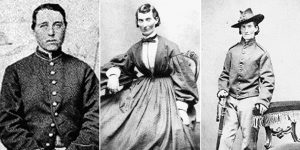 dans l’Ouest (seule) ou qui souhaitait réussir sa vie (notamment durant la ruée vers l’or) devait trouver un moyen de devenir un homme. Parce que la tenue vestimentaire au XIXème siècle codifiait les genres, il était plus facile pour une femme de s’habiller en homme pour réussir. Elle devenait un homme. Les règles de l’Ouest (parfois les lois!) ordonnaient que seuls les hommes pouvaient porter un pantalon. Par conséquent, toute personne ayant un pantalon sur lui était vue comme un homme. Il y a des centaines d’exemples de femmes qui ont réussi leur travestissement dans l’Ouest. Malgré le fait que leur corps était un corps de femme, elles se voyaient elles-mêmes comme des hommes (ce que nous pourrions appeler aujourd’hui des transgenres ou des transexuelles) et l’époque et le lieu le permettaient plus facilement.
dans l’Ouest (seule) ou qui souhaitait réussir sa vie (notamment durant la ruée vers l’or) devait trouver un moyen de devenir un homme. Parce que la tenue vestimentaire au XIXème siècle codifiait les genres, il était plus facile pour une femme de s’habiller en homme pour réussir. Elle devenait un homme. Les règles de l’Ouest (parfois les lois!) ordonnaient que seuls les hommes pouvaient porter un pantalon. Par conséquent, toute personne ayant un pantalon sur lui était vue comme un homme. Il y a des centaines d’exemples de femmes qui ont réussi leur travestissement dans l’Ouest. Malgré le fait que leur corps était un corps de femme, elles se voyaient elles-mêmes comme des hommes (ce que nous pourrions appeler aujourd’hui des transgenres ou des transexuelles) et l’époque et le lieu le permettaient plus facilement.
.
.
.
Comment était perçue l’homosexualité (mot utilisé pour la première fois en 1868) à cette époque?
.
.
.
Au milieu du XXème siècle, le célèbre et controversé chercheur Alfred Kinsey avait réalisé une série d’interview à travers tous les Etats-Unis. Il avait constaté que les taux les plus fréquents d’homosexualité dans le pays se trouvaient dans les zones rurales et reculées en particulier dans l’Ouest américain. Selon lui, c’était monnaie commune pour les cow-boys, les ranchers, les fermiers, les chercheurs d’or ou les bûcherons d’avoir des relations sexuelles entre hommes. Cela pouvait s’expliquer au milieu du XXème siècle par l’isolation et l’animosité que l’on retrouvait dans l’Ouest américain. Il en était sûrement de même au XIXème siècle. Alfred Kinsey a pu obtenir des réponses à ses questions indiscrètes. Mais pour les historiens qui ne peuvent recueillir des témoignages du passé c’est plus difficile de faire un tel constat. L’hétérosexualité peut se mesurer par le nombre de naissances mais qu’en est-il des relations sexuelles sans la naissance d’enfants?
Les gens ordinaires écrivaient des lettres ou dans leur journal intime mais peu ne pouvaient témoigner de choses aussi intimes. Par conséquent, c’est un vrai problème d’étudier l’homosexualité dans l’Ouest américain.
Cependant, ce que nous savons c’est que les lois réglementaient la sexualité dans l’Ouest américain depuis les premières années de la présence européenne et euro-américaine. Il y a par contre peu d’exemples où des personnes durant les premières années auraient été dans l’illégalité. Quelques hommes furent arrêtés pour sodomie bien qu’à l’époque une telle pratique n’était pas interdite. C’est au XXème siècle où les villes et états dans l’Ouest ont adopté des lois et des peines plus contraignantes envers les homosexuels. Cela confirme que les relations sexuelles entre même sexe étaient probablement plus tolérées auparavant. Ce changement reste un mystère. Les historiens proposent plusieurs théories avec notamment la réorientation du genre. L’hétérosexualité et l’homosexualité ont fini par définir les catégories de personnes et des mesures plus rigides ont codifié les mentalités.
Pour mon livre Same-Sex Affairs (2003), j’ai étudié l’évolution de l’industrie dans les états de l’Oregon, de Washington, de l’Idaho et un peu du Montana et de la province canadienne de la Colombie britannique. Plusieurs métiers se sont multipliés comme bûcherons, pêcheurs,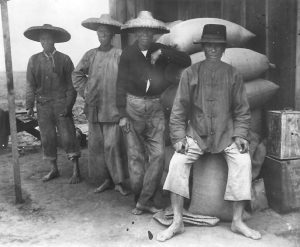 mineurs, constructeurs de chemins de fer. Tout cela a amené plus beaucoup de jeunes hommes que de femmes. Toute cette population masculine et ouvrière a développé une culture sexuelle entre hommes jeunes (des adolescents étaient présents) et des plus âgés. Tout cela a fini par attirer l’attention des classes moyennes et supérieures du Nord-Ouest du Pacifique alors que les zones urbaines grandissaient.
mineurs, constructeurs de chemins de fer. Tout cela a amené plus beaucoup de jeunes hommes que de femmes. Toute cette population masculine et ouvrière a développé une culture sexuelle entre hommes jeunes (des adolescents étaient présents) et des plus âgés. Tout cela a fini par attirer l’attention des classes moyennes et supérieures du Nord-Ouest du Pacifique alors que les zones urbaines grandissaient.
Ces jeunes hommes ouvriers, qui étaient souvent noirs ou d’origine étrangère (chinois, asiatiques, grecs), choquaient les classes au pouvoir. Les sources prouvent que les lois ont alors réglementé la sexualité et parfois des peines ont été promulguées.
.
.
.
Qu’est-ce qu’étaient les bachelor marriages?
.
.
.
Il est difficile de savoir comment le terme de bachelor marriage était utilisé au XIXème siècle car nous disposons de peu de sources. Bret Harte (1836-1902), un célèbre écrivain de western et poète de la fin du XIXème siècle a utilisé l’expression dans ses écrits lorsqu’il décrivait la liaison entre hommes lors de la ruée vers l’or. Henry James (1843-1916), un des plus grands écrivains de l’époque, utilisait quant à lui le terme de “Boston marriage”, lequel a connu un certain succès et qui décrivait souvent des femmes de classe moyenne qui couchaient ensemble. C’était en particulier dans le Nord-Est des Etats-Unis après la Guerre de Sécession.

Le plus important dans l’Ouest américain était que l’expression “bachelor marriage” était une réalité. Il n’était pas inhabituel que deux hommes puissent se mettre ensemble (les cow-boys ou les mineurs sont de bons exemples). Ils partageaient tout simplement leur vie ensemble. Un des exemples les plus connus est la vie commune entre 1837 et 1841 du prochain président américain Abraham Lincoln et du marchand Joshua Speed. Non seulement ils vivaient ensemble au-dessus du magasin de Speed à Springfield mais ils partageaient le même lit.
Qu’ils aient eu ou non des relations sexuelles ensemble n’était pas un problème à l’époque. De telles relations prouvent que le système social prenait racine autrement qu’aujourd’hui. Le XIXème siècle avait une société où les genres ne se mélangeaient pas. Vos plus proches amis étaient du même sexe. La part écrasante d’hommes dans l’Ouest a permis ces bachelor mariages comme décrit l’étude de Bret Harte. Il pouvait très bien y avoir des relations sexuelles entre eux mais il fallait que les personnes soient surtout du même rang social.
.
.
.
Le travestissement et les relations sexuelles entre le même sexe étaient également présents chez les Indiens. La culture européenne a-t-elle mis un terme à cela?
.
.
.
Oui il est évident que les Européens et les Euro-américains ont eu un impact sur la société  indienne et donc sur la sexualité et le genre. Beaucoup d’Indiens qui ne se sentaient pas à l’aise avec leur identité sexuelle et faisaient le choix de la changer. Un homme qui se sentait
indienne et donc sur la sexualité et le genre. Beaucoup d’Indiens qui ne se sentaient pas à l’aise avec leur identité sexuelle et faisaient le choix de la changer. Un homme qui se sentait
femme s’habillait avec des tenues féminines, faisaient des tâches attribuées aux femmes. Cela était tout à fait accepté. Une femme pouvait très bien devenir un homme également. Ils n’étaient pas perçus comme homosexuels car ils pouvaient très bien se marier et avoir des enfants. Cependant, toutes les tribus n’autorisaient pas cela et le Christianisme, l’éducation par l’école et d’autres facteurs de « l’acculturation » ont mis fin à de telles coutumes. Il est possible que cela ait continué mais de façon plus discrète.
Encore de nos jours, des Indiens américains et canadiens se revendiquent lesbiens, gays, transexuels ou transgenres et peuvent être appelés « Deux-esprits » en lien avec leurs vieilles traditions.
.
.
.
Quelle était la vie quotidienne d’une prostituée (hommes et femmes) dans l’Ouest américain?
.
.
.
La vie des prostituées (beaucoup d’historiens les appellent « travailleurs du sexe » depuis que c’est devenu moins péjoratif) pouvait être très différente selon l’endroit et l’époque. Certains chercheurs ont remarqué que les prostituées vivant au début de la conquête de l’Ouest dans 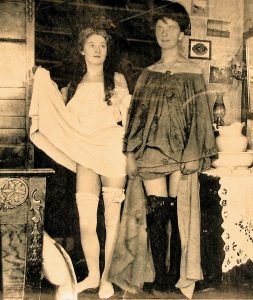 les régions isolées (par exemple dans les communautés de chercheurs d’or) ont eu un plus grand contrôle sur leur business et un plus grand profit que des années plus tard. Lorsque la société s’est installée, que les lois se sont imposées à tous et que la prostitution devint plus contrôlée par les criminels, cela changea.
les régions isolées (par exemple dans les communautés de chercheurs d’or) ont eu un plus grand contrôle sur leur business et un plus grand profit que des années plus tard. Lorsque la société s’est installée, que les lois se sont imposées à tous et que la prostitution devint plus contrôlée par les criminels, cela changea.
Les travailleuses du sexe devinrent les employées de d’hommes plutôt que de femmes. Elles obtenaient moins d’argent et avaient moins de contrôle.
Certaines tenancières ont sûrement tenu des maisons closes mais ce n’était pas monnaie courant. D’autres études ont révélées que la prostitution était souvent synonyme de dur labeur, d’alcoolisme, d’addiction aux drogues et de violence. Nous connaissons des histoires de prostituées qui ont fuit le business et sont devenues des femmes respectables.
N’oublions pas non plus que beaucoup d’immigrantes sont devenues de travailleuses du sexe contre leur gré notamment les Chinoises.
Ce qui est moins connu ce sont les prostitués hommes. J’en parle dans certains de mes livres. Dans des villes comme San Francisco, Denver ou Portland, des jeunes de familles ouvrières vivaient dans la ville et vendaient leur corps à d’autres ouvriers pour de l’argent ou pour soutenir leur fratrie. Certains même souhaitaient s’acheter des billets pour aller au cinématographe.
Des hommes en ville se déguisaient en femme pour jouer sur scène ou chanter dans les saloons. Ils pouvaient également offrir leur corps. Leur vie quotidienne était un peu plus dure que celles des femmes prostituées qui étaient plus nombreuses et donc solidaires entre elles.
.
.
.
Savons-nous plus sur les lesbiennes dans le Grand Ouest?
.
.
.
Cela dépend de ce que vous appelez le « Grand Ouest ». Dans mes recherches sur les femmes comme pour les hommes, j’ai pu trouver des sources plus sûres qui dataient de la fin du 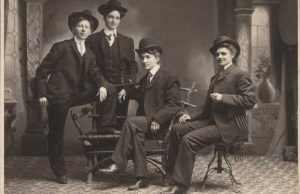 XIXème siècle. Il est même plus difficile de trouver des preuves de lesbianisme que d’homosexualité masculine. Les femmes étaient plus exclues de l’espace public et ne pouvaient s’oser à participer à des activités sexuelles interdites (à l’exception des prostituées). Cependant, les femmes n’étaient pas interdites de sodomie mais étant surtout recluses dans leurs foyers, elles avaient peu de possibilités d’en sortir.
XIXème siècle. Il est même plus difficile de trouver des preuves de lesbianisme que d’homosexualité masculine. Les femmes étaient plus exclues de l’espace public et ne pouvaient s’oser à participer à des activités sexuelles interdites (à l’exception des prostituées). Cependant, les femmes n’étaient pas interdites de sodomie mais étant surtout recluses dans leurs foyers, elles avaient peu de possibilités d’en sortir.
La preuve la plus importante de lesbianisme que j’ai pu trouver vient de ces femmes qui s’habillaient et qui vivaient comme des hommes. Ainsi, elles pouvaient avoir un meilleur accès à l’espace public. Mais si elles étaient découvertes ainsi, cela provoquait des scandales, des arrestations, des jugements et des articles de journaux. Leur vie, même leur sexualité, était alors révélée au grand jor. Beaucoup de ses femmes travesties étaient en couple avec d’autres femmes. Mais certaines de ces « lesbiennes » ne se voyaient pas en tant qu’homosexuelles mais plutôt comme ce que l’on pourrait appeler aujourd’hui des transgenres.
D’autres preuves de lesbianisme viennent de rapports médicaux. Un médecin a notamment publié des études sur la vie sexuelle de ses patients et patientes. La meilleure preuve date des années 1890-début du XXème siècle lorsque des femmes furent capables de vivre indépendamment des hommes grâce aux changements politiques, à leur travail et à leur rang social. Leur attirance pour d’autres femmes a pu alors davantage se libérer.
.
.
.
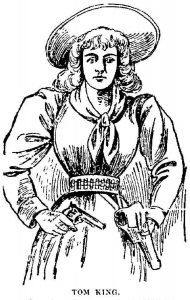
.
.
.
Pour en savoir plus:
Le livre de Peter Boag: « Re-Dressing America’s Frontier Past »
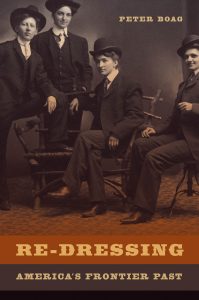
Sexuality, Gender, and Sex-Work: A New History of the Old West
Americans have long cherished romantic images of the frontier and its colorful cast of characters, where the cowboys are always rugged and the ladies always fragile. However, cross-dressing and same-sex relationships were common in the old American west. In this book, Peter Boag, Professor and Columbia Chair in the History of the American West, opens an extraordinary window onto the real Old West. Needless to say, we have some great questions about it.
.
.
.
From Europe, Africa, Asia or Latin America, did the new comers find a land with no binding rules (Homosexuality, cross dressing,…) ?
.
.
.
I would not characterize the American West of the 19th century as a place of “no binding rules.” There were indeed vast stretches of the American West that went relatively unregulated. Likewise, the social atmosphere where a variety of immigrants and others came together was one of considerable flux. But rules did exist – rules about race and gender based on cultural heritage that immigrants brought with them, rules emanating from different imperial and state authorities, and rules that local communities applied.
I found in my research on cross-dressers in the 19th-century West that rigid rules and a rigid social atmosphere actually could allow and even encourage people to dress and live the lives of members of the other sex, something that seemingly contradicted the rules! A good example of this is that the Old West, however open it may have seemed, was still really a man’s world: men outnumbered women; the best paying jobs were usually men’s jobs; and men pretty much controlled the economy and politics. For a woman who wanted to safely travel to the West (on her own) or for a woman who wanted to benefit from the (supposed) wealth one could obtain there (like heading off to one of the varied gold rushes), she often found that the only way she could do so was to disguise herself and literally become a man. Because clothing was so gender coded in the 19th-century western world, it was easier for a woman who dressed as a man to succeed in her disguise. That is, the rules (sometimes  laws!) dictated that only men could wear pants and thus it was assumed that only men did wear pants. When an unsuspecting person happened to glance at another person and saw that that person was wearing pants, the observer naturally assumed, according to the rules that everyone knew, that the person being observed must be a man. So, a woman who disguised herself as a man benefited from the rigid rules that influenced how people actually saw things. There are hundreds of examples of women who succeeded in their male disguise in the Old West. What this situation or atmosphere also allowed for, then, was for those people who had recognizably female bodies, but felt themselves to be male (what we today might call transgender or transsexual people) greater opportunity to be themselves then they might have in other times and in other places.
laws!) dictated that only men could wear pants and thus it was assumed that only men did wear pants. When an unsuspecting person happened to glance at another person and saw that that person was wearing pants, the observer naturally assumed, according to the rules that everyone knew, that the person being observed must be a man. So, a woman who disguised herself as a man benefited from the rigid rules that influenced how people actually saw things. There are hundreds of examples of women who succeeded in their male disguise in the Old West. What this situation or atmosphere also allowed for, then, was for those people who had recognizably female bodies, but felt themselves to be male (what we today might call transgender or transsexual people) greater opportunity to be themselves then they might have in other times and in other places.
.
.
.
When normal gender roles (women weren’t present in large communities) were challenged, how was seen homosexuality (a word that wasn’t even used until 1868!) during that time (was it still forbidden)? In all the American West society?
.
.
.
In the mid-20th century, the well-known and somewhat controversial American sex researcher Alfred Kinsey conducted interviews with many subjects across the United States. He found that the highest frequencies of homosexuality in the country were in rural communities and remote areas, particularly the American West. He explained that it was not unusual for ranchers, cattlemen, prospectors, farmers, and loggers to engage in same-sex acts. These findings from the mid-20th century would suggest that the relative isolation and anonymity that the American West might provide, could encourage the expression of same-sex love and lust in the 19th-century West. Alfred Kinsey was able to conduct interviews with people who were willing to answer his prying questions. But for historians working with the past, it is actually very difficult to find written records about sex acts (outside of legal documents). Heterosexual intercourse is a bit easier to figure out: there are often children to prove that heterosexual sex took place. But how does one find a record of sex acts that do not produce children? “Average” people, in their letters and in their diaries, were and are pretty reticent about writing about their sex acts, since this is so personal. So, it is problematic to measure how open the American West in the 19th century was to things like the expression of same-sex love (or lust) through sex acts.
What we do know, however, is that laws regulating sex existed in the American West since the earliest times of European and Euroamerican presence there. In early years, however, there are actually few instances where people are prosecuted for breaking these laws. Few men, for example, were arrested for sodomy, even though it was outlawed. This changed at the turn of the 20th century when towns, cities, and states in the American West adopted harsher and more specific penalties for people who were found to engage in homosexual relations. This suggests that same-sex sex acts and love may have been more tolerated earlier in western history (but whether or not it happened is still hard to know). Why the change eventually happened is a bit of a mystery. Historians offer different theories for why this happened, noting that it had something to do with the reorientation of gender and sexual norms — for example, the creation of heterosexuality and homosexuality as categories to define people and the increasingly rigid ways in which these came to define personalities and thus who stood inside and outside the law.
In my book Same-Sex Affairs (2003), in which I look specifically at the states of Oregon, Washington, and Idaho, and a little bit at Montana and the Canadian province of British Columbia, I note that the appearance in the late 19th century of large numbers of jobs in burgeoning extractive and construction industries such as logging, fishing, mining, and  railway-building, drew to the region large numbers of young single men, creating even a greater imbalance in the ratio of males to females than ever. This largely all-male, working-class society developed a sexual culture that permitted expressions of same-sex sex, especially between older and younger males (juveniles were also part of this work force). As more men and boys participated in this sex culture, they naturally came to the attention of the middle and upper classes that were at the same time trying to create a respectable, family-oirented society in the Pacific Northwest as the population grew, urban areas developed, and the economy became more complex. That these working men and youths were also from the “lower” classes and many were racial minorities (African Americans) and immigrants (Chinese, South Asians, Greeks), heightened the concern of the white, respectable classes in power. Those sources of power expanded laws regulating sexual expression and also harshened penalties for sex considered unacceptable in an attempt to achieve the society they desired. But this only hardened the boundaries between homosexuality and heterosexuality, funneling people, based on their sexual activities, into these categories, and funneling more and more people accused of same-sex activities into the penal system.
railway-building, drew to the region large numbers of young single men, creating even a greater imbalance in the ratio of males to females than ever. This largely all-male, working-class society developed a sexual culture that permitted expressions of same-sex sex, especially between older and younger males (juveniles were also part of this work force). As more men and boys participated in this sex culture, they naturally came to the attention of the middle and upper classes that were at the same time trying to create a respectable, family-oirented society in the Pacific Northwest as the population grew, urban areas developed, and the economy became more complex. That these working men and youths were also from the “lower” classes and many were racial minorities (African Americans) and immigrants (Chinese, South Asians, Greeks), heightened the concern of the white, respectable classes in power. Those sources of power expanded laws regulating sexual expression and also harshened penalties for sex considered unacceptable in an attempt to achieve the society they desired. But this only hardened the boundaries between homosexuality and heterosexuality, funneling people, based on their sexual activities, into these categories, and funneling more and more people accused of same-sex activities into the penal system.
.
.
.
What were bachelor marriages?
.
.
.
How extensively the term “bachelor marriage” was used in the 19th century is a bit difficult to determine, but that it was occasionally used has been documented. Bret Harte (1836-1902), a notable western writer and poet of the late 19th century, for example, used the term in his writings when he described pairings between men in California gold-rush society. Henry James (1843-1916), one of the most successful American novelists of the same era, coined the term “Boston marriage,” a term that caught on and was often used to describe women of the middle-classes, particularly in the northeastern U.S. in the post-Civil War era, who formed long-term committed relationships with each other.

More important in the American West than the actual term “bachelor marriage” was the fact of its existence. It was not unusual for two men to form long-term relationships with each other (cowboys and miners are good examples) wherein they shared their lives and companionship. One of the best known “bachelor marriages” that occurred on the western prairies between 1837 and 1841 involved the later-president Abraham Lincoln and the merchant Joshua Speed. Not only did they live together above Speeds store in Springfield, Illinois, but they even shared the very same bed!
Whether Lincoln’s and Speed’s relationship or any of these “bachelor marriages” had a sexual component is not a simple matter to figure out. I think more important than sex, is that these relationships evince a social system rooted in another time and place. The 19th century was a gender-bifurcated society. It was expected that your closest friendships would be with people of the same sex. This, when coupled with the overwhelming number of men compared to women in the West, contributed to the high incidence of “bachelor marriages” there, as the work of Bret Harte depicts. If people in these relationships had sex with each, they may very well have done so, but living together in a close relationship would not have given them away, since these relationship were socially acceptable, even expected. This is another way in which rigid rules might permit something that was otherwise unintended.
.
.
.
Cross dressing & same-sex activities were also part of the Indian society. Is it the European culture that annihilated those aspects?
.
.
.
Yes, evidence is clear that European and Euroamerican culture seriously impacted Indian society, and by extension Native American sexuality and gender norms. A tradition common to many Native American tribes was the acceptance of roles for their tribal members who did not feel comfortable with the gender roles usually ascribed to their biological sex. So a male who felt himself to be more like a female, preferred female clothing, preferred doing female  work, and may have acted in ways seen more feminine, would be allowed to live and work as a woman. The same applied to a female who felt more like a male, preferred male clothing and work, and may have acted in was seen as more masculine. (By the way, these people were not necessarily “homosexual”; they may have married a person of the other sex and had children.) Not all tribes did allow for this, it must be said; some had social proscriptions against such gender expressions. But for those tribes that did, evidence shows that subjection to Christianity, the boarding-school experience, and other aspects of the “acculturation” process did bring to an end in those tribes acceptance of gender and sexual diversity, or in some cases may have just driven it underground. For some years now, Native Americans in the U.S. and members of First Nations in Canada who are lesbian, gay, transsexual, transgender, or otherwise what they might call “Two-Spirit,” have been trying to bring back these traditions.
work, and may have acted in ways seen more feminine, would be allowed to live and work as a woman. The same applied to a female who felt more like a male, preferred male clothing and work, and may have acted in was seen as more masculine. (By the way, these people were not necessarily “homosexual”; they may have married a person of the other sex and had children.) Not all tribes did allow for this, it must be said; some had social proscriptions against such gender expressions. But for those tribes that did, evidence shows that subjection to Christianity, the boarding-school experience, and other aspects of the “acculturation” process did bring to an end in those tribes acceptance of gender and sexual diversity, or in some cases may have just driven it underground. For some years now, Native Americans in the U.S. and members of First Nations in Canada who are lesbian, gay, transsexual, transgender, or otherwise what they might call “Two-Spirit,” have been trying to bring back these traditions.
.
.
.
What was the daily life of a prostitute (women and men) living in the American west?
.
.
.
The lives and experiences of prostitutes, what many historians call “sex workers” (since it has a less pejorative ring to it) varied greatly from place to place and over time in the American West. Some scholarship on women sex-workers in the American West argues that in earlier periods in more unsettled regions of the West (for example in young gold-rush  communities), women sex-workers were more likely to have greater control over the business and reap greater profit it from it than they did in later years, when society became more settled, laws more stringent, and prostitution more regulated. In those later years, prostitution was largely driven underground and men of the criminal world usually took control of the business. Women sex-workers would then become laborers of these men, rather than for themselves or other women, making considerably less money and having less say in the business.
communities), women sex-workers were more likely to have greater control over the business and reap greater profit it from it than they did in later years, when society became more settled, laws more stringent, and prostitution more regulated. In those later years, prostitution was largely driven underground and men of the criminal world usually took control of the business. Women sex-workers would then become laborers of these men, rather than for themselves or other women, making considerably less money and having less say in the business.
The highly romanticized western madams operating brothels certainly did exist, but this was not the norm and, as I suggested above, tended to be relegated to earlier years on the western American frontier. Other studies have been done that depict western prostitution as menial work where drudgery, alcoholism, drug addiction, and violence were common. We do know stories where western prostitutes made it out of the business and became respectable members of the community. Not to be forgotten, of course, are the many immigrant and racial minority women who were sex-workers, many against their will, as was typically the case with Chinese prostitutes.
Less known were male sex-workers, some of whom I have written about in a couple of my books. Western urban centers such as San Francisco, Denver, and Portland typically had youths who lived on the streets or came from working-class families and sold sex to working-class men for money to supplement their family’s income, or because they wished to get extra money to go to the moving-picture show. There also were a number of male-bodied people who worked in towns and cities as female impersonators, whether on the stage or singing in saloons. They also earned additional income by selling sex. Their daily lives are a little more difficult to access than women prostitutes, who (at least according to documents that have thus surfaced) were more numerous.
.
.
.
Do we know more about lesbians in the Old West?
.
.
.
It depends what you mean by the “Old West.” In my research on women, as is the case for men, I have been able to locate more verifiable records on their sexuality the closer to the end of the 19th century one gets. It is even more difficult to find evidence of lesbian sexuality than it is for men who had sex with men. The reason being, women were largely excluded from the public world and simply did not show up in arrest records for sex crimes (unless they were female sex-workers catering to men). Also, certain laws regulating same-sex sex acts usually did not apply to women, such as sodomy. But, because women were largely relegated to the domestic world, they are usually just absent from the public record.
The best evidence I have found for women who had sexual relationships with each other  comes from my work that traces women who dressed and lived as men. Because as men they entered the public world, they were more likely to be arrested as men. When discovered to be women, or at least having bodies understood to be the female body, such women caused a considerable sensation and police detectives, trial judges, and newspapers wanted to learn as much about them as possible, including their sex lives. Any number of these cross-dressing women had female companions, with whom they had sexual relations. But were these lesbians, or were they people we would call (today) transgender? Some of the evidence demonstrates without a doubt that some saw themselves as men, and thus their relations with women are not truly homosexual in nature.
comes from my work that traces women who dressed and lived as men. Because as men they entered the public world, they were more likely to be arrested as men. When discovered to be women, or at least having bodies understood to be the female body, such women caused a considerable sensation and police detectives, trial judges, and newspapers wanted to learn as much about them as possible, including their sex lives. Any number of these cross-dressing women had female companions, with whom they had sexual relations. But were these lesbians, or were they people we would call (today) transgender? Some of the evidence demonstrates without a doubt that some saw themselves as men, and thus their relations with women are not truly homosexual in nature.
Other evidence for lesbianism that I have come across include medical reports, wherein a physician is publishing his investigations of the sex lives of some of his patients. The best evidence for lesbianism in the West, however, really comes from the 1890s and beyond, especially the first years of the 20th century, when women, due to social, economic, and political changes were increasingly able to construct lives independent from men. For those who had sexual interests in other women, this changing atmosphere made it increasingly possible for them to act on those interests.
.
.
.

Further reading:
Re-Dressing America’s Frontier Past by Peter Boag

